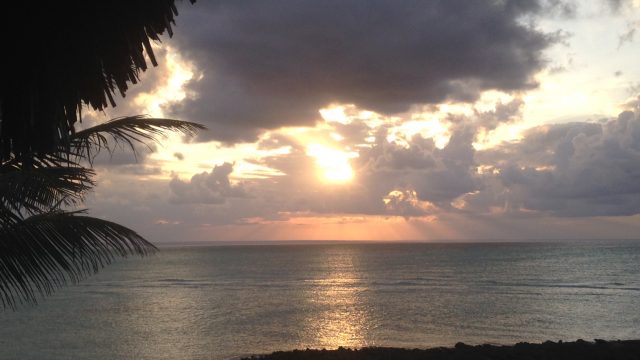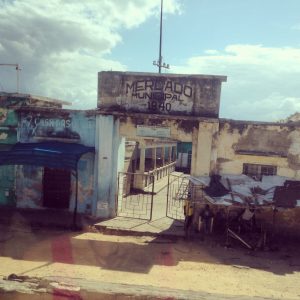Mozambique’s Quirimbas archipelago has become something of a holiday hotspot in recent years, as well-heeled vacationers bypass the now-familiar resorts near Maputo, Inhambane and Vilanculos in search of more off-the-beaten-path destinations.
The jumping-off point is Pemba, where I spent a night before jetting off to an island further north. A small city of about 150,000 in the northern province of Cabo Delgado, Pemba still feels a lot like the small fishing village it started out as. A smattering of laid-back beaches line the massive bay, sleepy bars and friendly seafood restaurants are tucked into quiet pothole-filled streets, and men selling still-flapping fish congregate at intersections. Muslim women in brightly-colored hijabs wander to and fro, bargaining hard at the quintessentially African markets. The local Mozambican/Portuguese market offers primarily produce, meat and clothing, while at the Swahili market hawkers from around East Africa sell electronics, mattresses, furniture and bric-a-brac.
Hundreds upon hundreds of bamboo-sided huts line the dusty roads, whose gutters are lined with trash — the only blight on an otherwise pleasant town whose municipal authorities are obviously not motivated (or funded) to beautify. This may change as the city grows more and more popular with business travelers and upper-class Mozambicans seeking a bit of R&R. At the moment Pemba is not quite a leisure destination — its hotels are primarily inhabited by those who work in Mozambique’s burgeoning offshore oil and gas exploration industry (for which Pemba is the hub city).
My address in Pemba was the AVANI Pemba Beach Hotel & Spa, an immaculate — though somewhat sterile — establishment which caters specifically to the business crowd. The expansive property, which blends Arabic and African architectural styles, has 100 traditional rooms, plus 82 brand-new self-catering apartment units that are popular with corporate travelers.
Though the property has four pools, several tennis courts and watersports activities like snorkelling, sailing, skiing, wakeboarding and kayaking, gloomy skies and limited time led me to the superb onsite spa, which turned out to be an excellent choice. Many resorts have massage therapists who give what I call “resort massages” — too little pressure for too much money. But at Avani spa, the highly-trained therapist knew exactly how to loosen up my writing-tensed arms and hands, and left me in a state of bliss which lasted well throughout the evening.
Dinner was at the upscale, open-air seafood restaurant, Clube Naval, where platters of fresh lobster, crab, linefish and calamari kept coming and coming and coming. Not that I was complaining. Baked Alaska and chocolate mousse cake rounded out the evening and left everyone in my group moaning a little as they dragged their bloated bellies back to their respective rooms.
The following day’s flight to the private island of Medjumbe took about 40 minutes in a 12-seat puddle jumper, including a 5-minute stop at Ibo island en route.
Ibo and Medjumbe are just two of 32 islands in the 250km-long Quirimbas archipelago, which starts near Pemba and extends up almost to the border of Tanzania. The southernmost islands are part of Quirimbas National Park, which encompasses 750,639 hectares (1,854,870 acres) of coastal forest, mangroves and coral reefs.
We dropped off two travelers at Ibo airport, which was no more than a well-mowed field, with a crumbling concrete shelter that turned out to be the “terminal.” Medjumbe’s 500m-long tarred landing strip, which hugged the edge of the sea, seemed state-of-the-art in comparison.
Home to just a single resort, Anantara Medjumbe Island Resort & Spa, the apostrophe-shaped island is where I spent the next two nights. A stereotypically perfect “paradise island,” it’s hard not to use cliches when describing it. Surrounded by transparent cerulean seas and populated with hundreds of gently swaying palms, it sports a narrow white sand spit that dangles off into the ocean like a stray fishing line. It is shockingly gorgeous, idyllic and remote — so remote that it would be fit for the privacy-seeking likes of Brad & Angelina, were they to seek a secret Indian Ocean hideaway.
It’s also tiny, I should mention. At just 1km long and a few hundred meters wide, Medjumbe only takes about 30 minutes to circumnavigate on foot, and perhaps a bit longer at low tide when the spit is revealed and the ribbed sand fields radiate out nearly half a kilometer in every direction. I highly recommend a walk (or kayak) around the island at sunrise or sunset, when the sky lights up like fireworks and tiny white sand crabs skitter across the sand as the gentle surf deposits driftwood shells and other detritus at your feet.
With just 12 villas, you’ll never have to worry about fighting crowds here, or finding privacy. (Which explains why Medjumbe is popular with honeymooners.) Each of the ocean-facing units has its own private plunge pool, outdoor shower and hammock, as well as air con, satellite TV, mini-bar, and a spacious bathroom.
The decor is understated island-chic, and the rooms are so comfortable you’ll be tempted to stay inside all day. Or lie on a lounge chair on your patio with a caipirinha in hand, watching dhows with their triangular sails bring home the day’s catch. There’s not much to do here, but that’s the idea.
However if you’re so inclined there are water sports, including scuba diving, snorkeling, kayaking, windsurfing, water skiing, tubing, wake-boarding, kite-surfing, fishing, and sunset cruises. The 25-to-30-degree water is home to a pristine eco-system and undiscovered reefs containing a dazzling array of fish from moray eels and stingrays to barracuda, kingfish and other pelagics. Dolphins, leatherback turtles, loggerheads and green turtles are often seen in the water, and humpback whales frequent the seas between July and October. The only thing to watch out for is the occasional bluebottle jellyfish, but their sting is not lethal, just irritating.
If you prefer to go completely Robinson Crusoe, book an afternoon at the uninhabited Quissanga Island, which sits about 10 minutes from Medjumbe by speedboat. Spend a few hours picnicking and braiing under the palms, sunbathing on the beach, birdwatching, or snorkeling. Schools of sweetlips, pufferfish, angelfish and triggerfish can be seen on days when visibility is good. Picnics are fully provisioned, including food, wine, cutlery and snorkeling equipment.
One cannot mention Medjumbe without waxing poetic about the food. Chef Nic Semple and his team incorporate seafood in nearly every meal — all obtained from local fishermen the day it is served. Lobster, crab and linefish are presented in various innovative ways that reflect Semple’s training at Le Quartier Français in Franschhoek. If you have the chance, try the divine crab curry.
Luckily with Medjumbe being so isolated, there is no malaria here and very few other insects, which makes outdoor dining a rather comfortable endeavor. You can choose from the dining area in the main lounge, a seat by the pool, or staff can set up a private table for two on the farthest reaches of the beach.
After two nights I was sorry to say goodbye to Medjumbe, and fearful of the torrent of e-mails and messages that was awaiting me back in the real world (internet connectivity is very limited on the island).
As our plane zoomed off down the coast, this magical island receded into the distance and memories of the warm hospitality, lazy days, and rustic surrounds were sadly drowned out by the drone of the propellers.
Details
AVANI Pemba Beach Hotel & Spa: To book or for more information visit www.avanihotels.com/pemba, or call +258 27 22 1770, or e-mail pemba@avanihotels.com.
Anantara Medjumbe: For rates and additional information, visit www.medjumbe.anantara.com, or call +27 11 658 0633, or e-mail medjumbe@anantara.com. Charter flights are available from Pemba to the island.
How to get to Pemba
Airlink, a regional feeder airline, offers a wide network of regional and domestic flights within southern Africa and operates as a franchisee to SAA.
They offer direct scheduled flights between Johannesburg and Pemba in northern Mozambique.
Through their alliance with SAA, travellers connect conveniently with SAA, their partner airlines and other carriers throughout southern Africa and the world.
Airlink is a member of South African Airways’ loyalty programme, Voyager.
How to book: Online, via booking agent, or via SAA Central Reservations at +27 11 978 1111.







